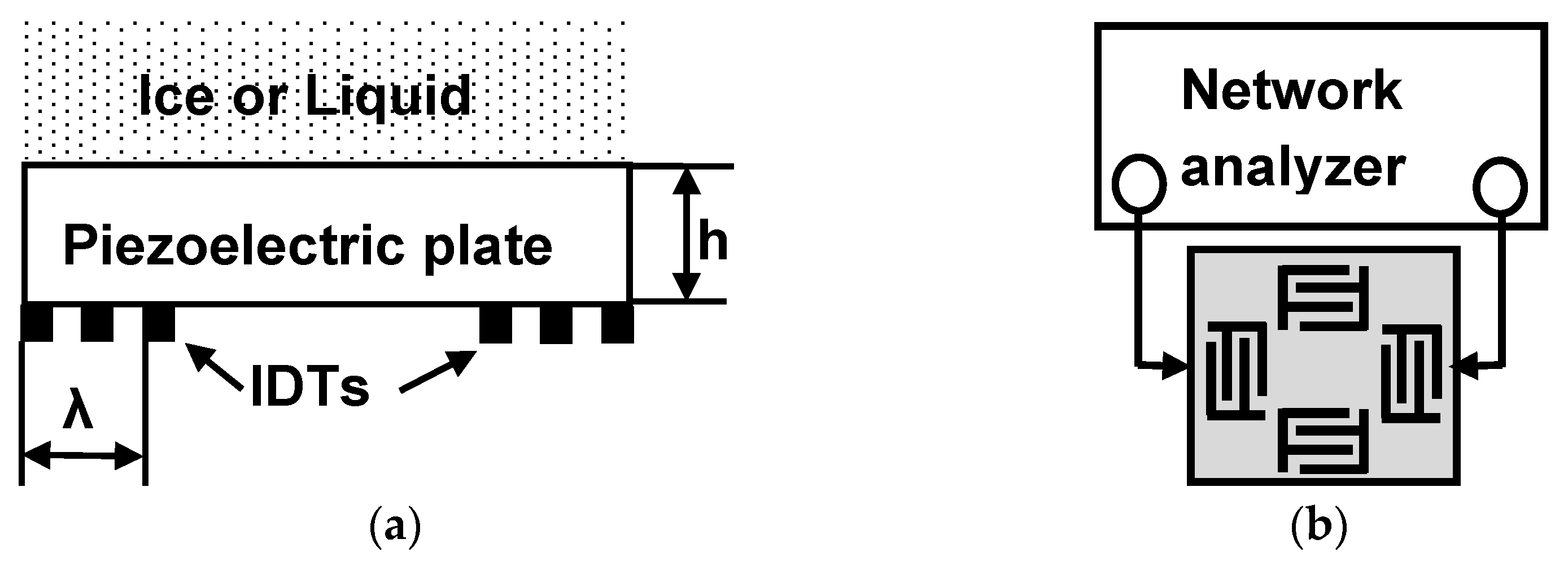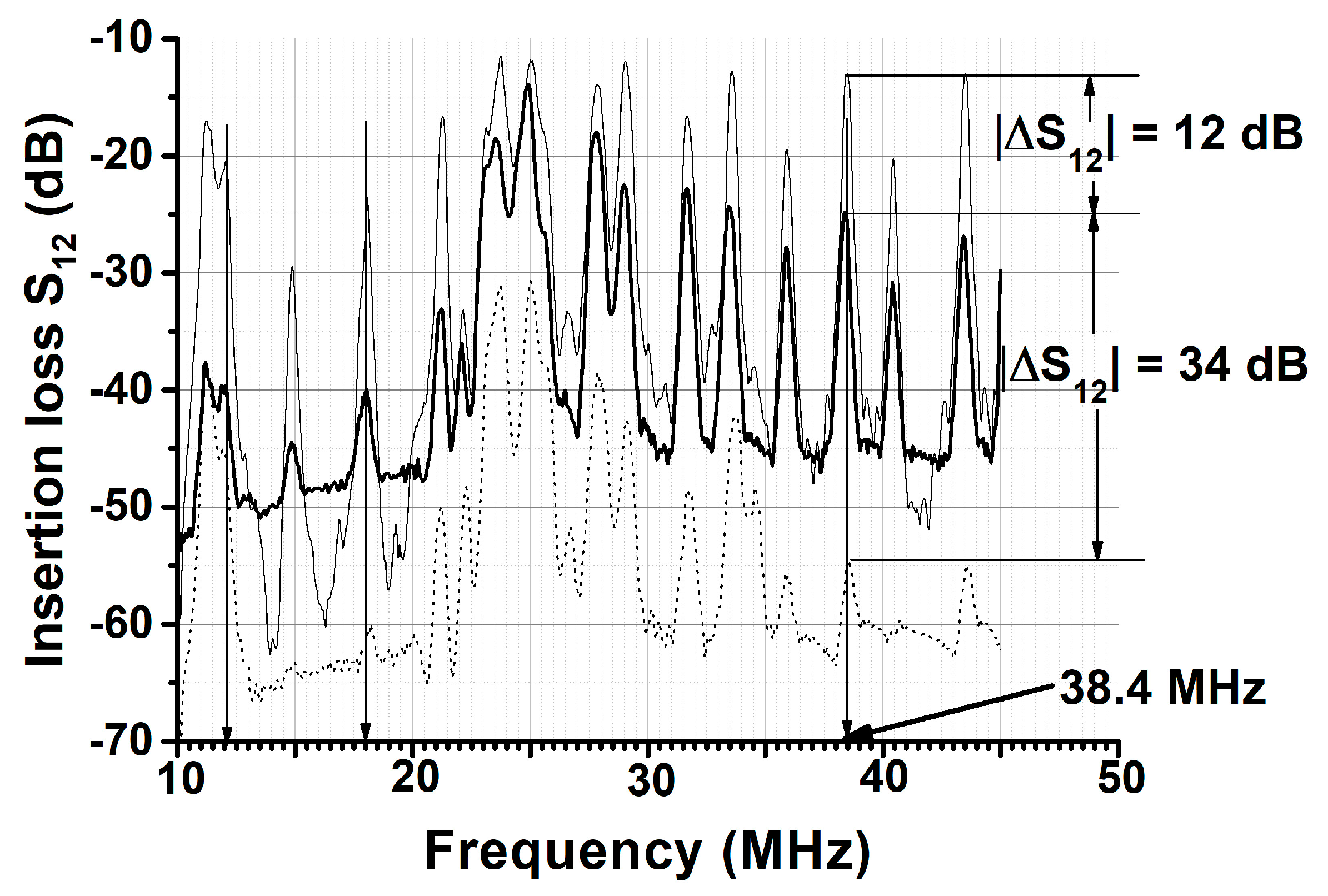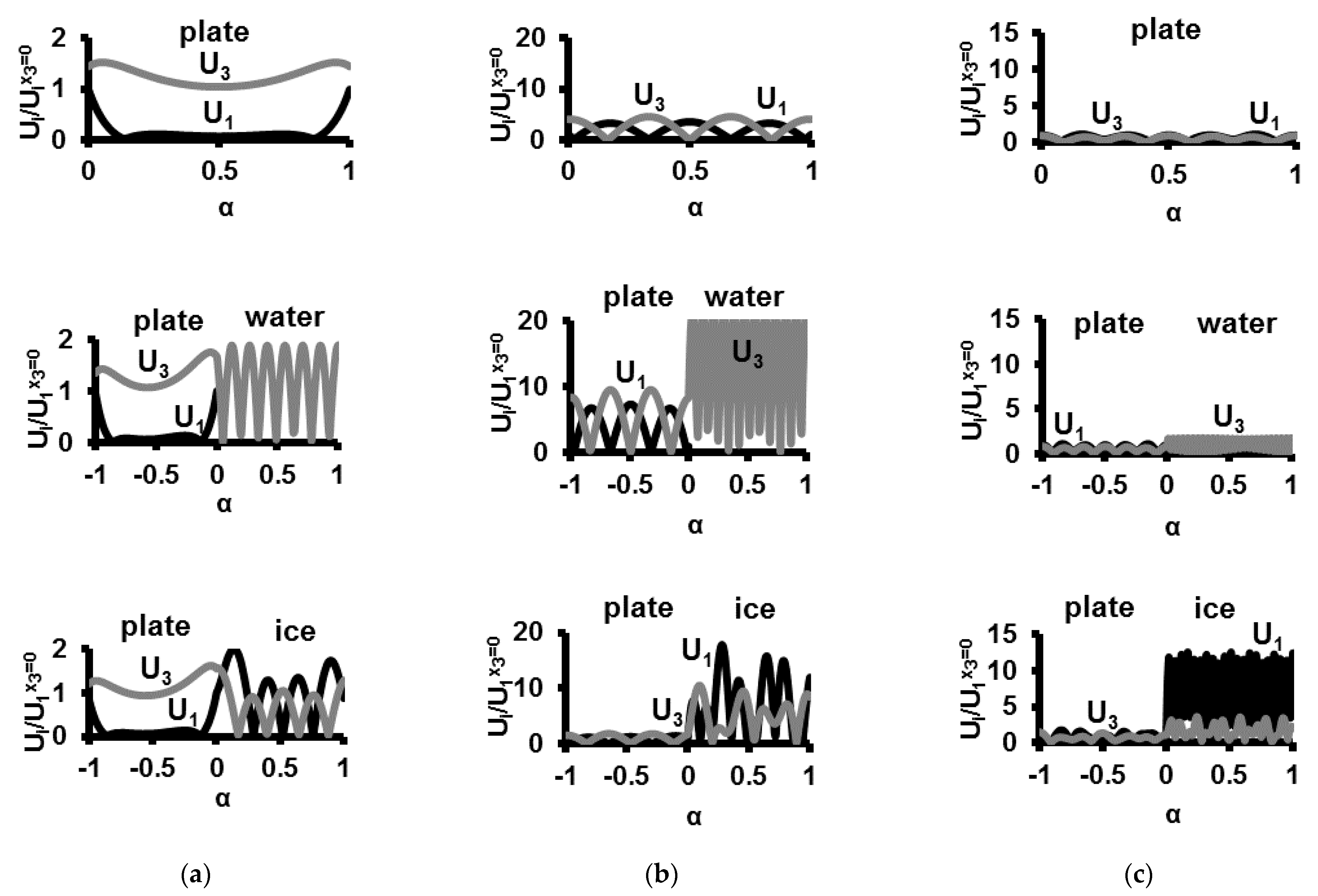An Analysis of the Water-to-Ice Phase Transition Using Acoustic Plate Waves
Abstract
1. Introduction
2. Materials and Methods
- -
- For delay lines with water loadings:
- -
- For delay lines with ice loadings:where TLair = 0.5 × , and TLlq and TLice in dB are the transduction losses of the input and output transducers (assumed to be identical) measured, respectively, without loading (air), with water (lq), and with ice (ice); Stlq and Stice in dB are the losses produced by scattering the wave at the plate/liquid and plate/ice steps (assumed identical to the liquid/plate and ice/plate steps); αlq and αice in dB/mm are the attenuation coefficients of a mode with water and ice loadings (assumed to be much larger than for air), respectively; the propagation paths coated with water or ice in the delay lines, as shown in Figure 2a–c, are 22.5, 10.5, and 12 mm, respectively. The numbers of linear equations and unknown parameters {TLlq, TLice, Stlq, Stice, αlq, αice} are equal to 6, so the solution of the system (1)–(6) is unambiguous. The precision of the solutions was about ±10%.
3. Results and Discussion
4. Conclusions
Author Contributions
Funding
Institutional Review Board Statement
Informed Consent Statement
Acknowledgments
Conflicts of Interest
References
- Tanaka, H.; Koga, K. Theoretical studies on the structure and dynamics of water, ice, and clathrate hydrate. Bull. Chem. Soc. Jpn. 2006, 79, 1621–1644. [Google Scholar] [CrossRef]
- Feistel, R.; Wagner, W. A new equation of state for H2O ice Ih. J. Phys. Chem. Refer. Data 2006, 35, 1021–1047. [Google Scholar] [CrossRef]
- Leetmaa, M.; Ljungberg, M.P.; Lyubartsev, A.; Nilsson, A.; Pettersson, L.G.M. Theoretical approximations to X-ray absorption spectroscopy of liquid water and ice. J. Electron Spectr. Relat. Phenom. 2010, 177, 135–137. [Google Scholar] [CrossRef]
- Pradzynski, C.C.; Forck, R.M.; Zeuch, T.; Slavicek, P.; Buck, U. A filly size-resolved perspective on the crystallization of water clusters. Science 2012, 337, 1529–1532. [Google Scholar] [CrossRef]
- Slater, B.; Michaelides, A. Surface premelting of water ice. Nat. Rev. Chem. 2019, 3, 172–188. [Google Scholar] [CrossRef]
- Wang, Y.; Li, F.; Fang, W.; Li, Y.; Sun, C.; Men, Z. Influence of Si quantum dots on water molecules icing. J. Mol. Liq. 2019, 291, 111315. [Google Scholar]
- Zhu, X.; Yuan, Q.; Zhao, Y.-P. Phase transitions of a water overlayer on charged graphene: From electromelting to eletrofreezing. Nanoscale 2014, 6, 5432–5437. [Google Scholar] [CrossRef]
- Bovo, L.; Rouleau, C.M.; Prabhakaran, D.; Bramwell, S.T. Phase transitions in few-monolayer spin ice films. Nat. Comm. 2019, 10, 1219. [Google Scholar] [CrossRef]
- Chakraborty, S.; Kahan, T.F. Physical characterization of frozen aqueous solutions containing sodium chloride and humic acid at environmentally relevant temperatures. ACS Earth Space Chem. 2020, 4, 305–310. [Google Scholar] [CrossRef]
- Jinesh, K.B.; Frenken, J.W.M. Experimental evidence for ice formation at room temperature. Phys. Rev. Lett. 2008, 101, 036101. [Google Scholar] [CrossRef]
- Kringle, L.; Thornley, W.A.; Kay, B.D.; Kimmel, G.A. Reversible structural transformations in supercooled liquid water from 135 to 245 K. Science 2020, 369, 1490–1492. [Google Scholar] [CrossRef] [PubMed]
- Myint, P.C.; Belof, J. Rapid freezing of water under dynamic compression. J. Phys. Condens. Matter. 2018, 30, 233002. [Google Scholar] [CrossRef] [PubMed]
- Parent, P.; Laffon, C.; Mangeney, C.; Bournel, F.; Tronc, M. Structure of the water ice surface studied by x-ray absorption spectroscopy at the O K-edge. J. Chem. Phys. 2002, 117, 10842–10851. [Google Scholar] [CrossRef]
- Zhu, S.; Bulut, S.; Le Bail, A.; Ramaswamy, H.S. High-pressure differential scanning calorimetry (DCS): Equipment and technique validation using water-ice phase transition data. J. Food Process Eng. 2004, 27, 359–376. [Google Scholar] [CrossRef]
- Caliskan, F.; Hajiyev, C. A review of in-flight detection and identification of aircraft icing and reconfigurable control. Prog. Aerosp. Sci. 2013, 60, 12–34. [Google Scholar] [CrossRef]
- Daniels, J. Ice Detecting System. U.S. Patent 4,775,118, 4 October 1988. [Google Scholar]
- Barre, C.; Lapeyronnie, D.; Salann, G. Ice Detection Assembly Installed on Aircraft. U.S. Patent 7,000,871, 21 February 2006. [Google Scholar]
- Anderson, M. Electro-Optic Ice Detection Device. U.S. Patent 6,425,286, 30 July 2002. [Google Scholar]
- Kim, J.J. Fiber Optic Ice Detector. U.S. Patent 5,748,091, 5 May 1998. [Google Scholar]
- Abaunza, J.T. Aircraft Icing Sensors. U.S. Patent 5,772,153, 30 June 1998. [Google Scholar]
- DeAnna, R. Ice Detection Sensor. U.S. Patent 5,886,256, 23 March 1999. [Google Scholar]
- Lee, H.; Seegmiller, B. Ice Detector and Deicing Fluid Effectiveness Monitoring System. U.S. Patent 5,523,959, 4 June 1996. [Google Scholar]
- Hansman, R.J.; Kirby, M.S. Measurement of ice growth during simulated and natural icing conditions using ultrasonic pulse-echo techniques. J. Aircr. 1986, 23, 493–498. [Google Scholar] [CrossRef]
- Vetelino, K.A.; Story, P.K.; Mileham, R.D.; Galipeau, D.W. Improved dew point measurements based on a SAW sensor. Sens. Actuators B 1996, 35, 91–98. [Google Scholar] [CrossRef]
- Galipeau, D.W.; Story, P.K.; Vetelino, K.A.; Mileham, R.D. Surface acoustic wave microsensors and applications. Smart Mater. Struct. 1997, 6, 658–667. [Google Scholar] [CrossRef]
- Varadan, V.K.; Varadan, V.V.; Bao, X.-K. IDT, SAW and MEMS sensors for measuring deflection, acceleration and ice detection of aircraft. Proc. SPIE 1997, 3046, 209–219. [Google Scholar]
- Hughes, R.S.; Martin, S.J.; Frye, J.C.; Ricco, A.J. Liquid-solid phase transition detection with acoustic plate mode sensors: Application to icing of surfaces. Sens. Actuators A 1990, 22, 693–699. [Google Scholar] [CrossRef]
- Vellekoop, M.J.; Jakoby, B.; Bastemeijer, J. A Love-wave ice detector. In Proceedings of the 1999 IEEE Ultrasonics Symposium, Caesars Tahoe, NV, USA, 17–20 October 1999; pp. 453–456. [Google Scholar]
- Joseб, K.A.; Sunil, G.; Varadan, V.K.; Varadan, V.V. Wireless IDT ice sensor. In Proceedings of the 2002 IEEE MTT-S International Microwave Symposium Digest (Cat. No. 02CH37278), Seattle, WA, USA, 2–7 June 2002; pp. 655–658. [Google Scholar]
- Gao, H.; Rose, J.L. Ice detection and classification on an aircraft wing with ultrasonic shear horizontal guided waves. IEEE Trans. Ultrason. Ferroelectr. Freq. Control 2009, 56, 334–343. [Google Scholar] [PubMed]
- Wang, W.; Yin, Y.; Jia, Y.; Liu, M.; Liang, Y.; Zhang, Y.; Lu, M. Development of Love wave based device for sensing icing process with fast response. J. Electr. Eng. Technol. 2020, 15, 1245–1254. [Google Scholar] [CrossRef]
- Anisimkin, V.I.; Voronova, N.V.; Zemlyanitsyn, M.A.; Kuznetsova, I.E.; Pyataikin, I.I. Characteristic features of excitation and propagation of acoustic modes in piezoelectric plates. J. Commun. Technol. Electr. 2013, 58, 1004–1010. [Google Scholar] [CrossRef]
- Kuznetsova, I.E.; Anisimkin, V.I.; Kolesov, V.V.; Kashin, V.V.; Osipenko, V.A.; Gubin, S.P.; Tkachev, S.V.; Verona, E.; Sun, S.; Kuznetsova, A.S. Sezawa wave acoustic humidity sensor based on graphene oxide sensitive film with enhanced sensitivity. Sens. Actuators B Chem. 2018, 272, 236–242. [Google Scholar] [CrossRef]
- Anisimkin, V.I.; Voronova, N.V. Features of normal higher-order acoustic wave generation in thin piezoelectric plates. Acoust. Phys. 2020, 66, 1–4. [Google Scholar] [CrossRef]
- Caliendo, C.; Castro, F.L. Quasi-linear polarized modes in y-rotated piezoelectric GaPO4 plates. Crystals 2014, 4, 228–240. [Google Scholar] [CrossRef]
- Chen, Z.; Fan, L.; Zhang, S.-Y.; Zhang, H. Theoretical research on ultrasonic sensors based on high-order Lamb waves. J. Appl. Phys. 2014, 115, 204513. [Google Scholar] [CrossRef]
- Wang, V.-F.; Wang, T.-T.; Liu, J.-P.; Wang, Y.-S.; Laude, V. Guiding and splitting Lamb waves in coupled-resonator elastic waveguides. Compos. Struct. 2018, 206, 588–593. [Google Scholar] [CrossRef]
- Kuznetsova, I.E.; Zaitsev, B.D.; Borodina, I.A.; Teplykh, A.A.; Shurygin, V.V.; Joshi, S.G. Investigation of acoustic waves of higher order propagating in plates of liyhium niobate. Ultrasonics 2004, 42, 179–182. [Google Scholar] [CrossRef]
- Anisimkin, I.V.; Anisimkin, V.I. Attenuation of acoustic normal modes in piezoelectric plates loaded by viscous liquids. IEEE Trans. Ultrason. Ferroelectr. Freq. Control 2006, 53, 1487–1492. [Google Scholar] [CrossRef]
- Adler, E.L.; Slaboszewics, J.K.; Farnell, G.W.; Jen, C.K. PC software for SAW propagation in anisotropic multilayers. IEEE Trans. Ultrason. Ferroelectr. Freq. Control 1990, 37, 215–220. [Google Scholar] [CrossRef] [PubMed]
- Kuznetsova, I.E.; Zaitsev, B.D.; Joshi, S.G.; Teplykh, A.A. Effect of a liquid on the characteristics of antisymmetric Lamb waves in thin piezoelectric plates. Acoust. Phys. 2007, 53, 557–563. [Google Scholar] [CrossRef]
- Available online: http://www.bostonpiezooptics.com/lithium-niobate (accessed on 16 December 2020).
- Slobodnik, A.J.; Andrew, J. The Temperature Coefficients of Acoustic Surface Wave Velocity and Delay on Lithium Niobate, Lithium Tantalate, Quartz, and Tellurium Dioxide. Available online: https://apps.dtic.mil/sti/citations/AD0742287 (accessed on 16 December 2020).
- Kuznetsova, I.E.; Zaitsev, B.D.; Joshi, S.G. Temperature characteristics of acoustic waves propagating in thin piezoelectric plates. In Proceedings of the IEEE Ultrasonics Symposium, Atlanta, GA, USA, 7–10 October 2001; pp. 157–160. [Google Scholar]
- Neumeier, J.J. Elastic constants, bulk modulus, and compressibility of H2O ice Ih for the temperature range 50 K–273 K. J. Phys. Chem. Ref. Data 2018, 47, 033101. [Google Scholar] [CrossRef]
- Irvine, T.E.; Kim, I.; Cho, K.; Gori, F. Experimental measurements of isobaric thermal expansion coefficients of non-newtonian fluids. Exp. Heat Transf. 1987, 1, 155–163. [Google Scholar] [CrossRef]
- Owen, B.B.; Miller, R.C.; Milner, C.E.; Cogan, H.L. Dielectric constants of water as a function of temperature and pressure. J. Phys. Chem. 1961, 65, 2065–2071. [Google Scholar] [CrossRef]
- Beiogol’skii, V.A.; Sekoyan, S.S.; Samorukova, L.M.; Stefanov, S.R.; Levtsov, V.I. Pressure dependence of the sound velocity in distilled water. Meas. Tech. 1999, 42, 406–413. [Google Scholar]







| Plate Material | fn, MHz | ||
|---|---|---|---|
| Y,Z-LiNbO3 | 38.4 | 11 | 34 |
| Y,Z+ 90°-LiNbO3 | 41.21 | 2.7 | 29 |
| ST,X+ 90°-SiO2 | 20 | 0.3 | 20 |
| ST,X-SiO2 | 19 | 0.2 | 9 |
| 36°Y, X+ 90°-LiTaO3 | 27.5 | 5.3 | 8 |
| 36°Y,X-LiTaO3 | 23 | 3.5 | 16 |
| # | Parameter and Delay Line Configuration | fn = 11.4 MHz | fn = 18.05 MHz | fn = 38.4 MHz |
|---|---|---|---|---|
| 1 | , dB | 9.4 | 17.0 | 11.4 |
| 2 | , dB (Figure 2a) | 35.1 | 41.4 | 22.0 |
| , dB (Figure 2b) | 28.4 | 30.7 | 16.3 | |
| , dB (Figure 2c) | 22.0 | 29.2 | 16.9 | |
| 3 | , dB (Figure 2a) | 37.1 | 57.8 | 56.0 |
| , dB (Figure 2b) | 29.2 | 44.4 | 36.0 | |
| , dB (Figure 2c) | 23.5 | 54.0 | 41.0 | |
| 4 | αlq, dB/mm | 1.5 | 1.75 | 0.5 |
| 5 | TLlq, dB | 3.5 | 6.8 | 5.8 |
| 6 | αice, dB/mm | 1.5 | 1.5 | 2 |
| 7 | TLice, dB | 6 | 12.2 | 7 |
| 8 | at T = 23 °C | 1.45 | 3.95 | 0.85 |
| 9 | at T = 23 °C | 1.67 | 8.3 | 0.82 |
| 10 | at T = −13 °C | 1.55 | 1.7 | 1.1 |
| 11 | (air), % at T = 23 °C | 3.9 | 0.3 | 1.12 |
| 12 | (lq), % at T = 23 °C | 2.9 | 0.16 | 0.9 |
| 13 | (ice), % at T = −13 °C | 3.1 | 0.01 | 0.06 |
| 14 | at T = 23 °C | 3450/3381 | 5375/5366 | 11,563/11,498 |
| 15 | at T = 23 °C | 3424/3373 | 5330/5325 | 11,496/11,444 |
| 16 | at T = −13 °C | 3442/3388 | 5215/5214 | 11,391/11,386 |
Publisher’s Note: MDPI stays neutral with regard to jurisdictional claims in published maps and institutional affiliations. |
© 2021 by the authors. Licensee MDPI, Basel, Switzerland. This article is an open access article distributed under the terms and conditions of the Creative Commons Attribution (CC BY) license (http://creativecommons.org/licenses/by/4.0/).
Share and Cite
Anisimkin, V.; Kolesov, V.; Kuznetsova, A.; Shamsutdinova, E.; Kuznetsova, I. An Analysis of the Water-to-Ice Phase Transition Using Acoustic Plate Waves. Sensors 2021, 21, 919. https://doi.org/10.3390/s21030919
Anisimkin V, Kolesov V, Kuznetsova A, Shamsutdinova E, Kuznetsova I. An Analysis of the Water-to-Ice Phase Transition Using Acoustic Plate Waves. Sensors. 2021; 21(3):919. https://doi.org/10.3390/s21030919
Chicago/Turabian StyleAnisimkin, Vladimir, Vladimir Kolesov, Anastasia Kuznetsova, Elizaveta Shamsutdinova, and Iren Kuznetsova. 2021. "An Analysis of the Water-to-Ice Phase Transition Using Acoustic Plate Waves" Sensors 21, no. 3: 919. https://doi.org/10.3390/s21030919
APA StyleAnisimkin, V., Kolesov, V., Kuznetsova, A., Shamsutdinova, E., & Kuznetsova, I. (2021). An Analysis of the Water-to-Ice Phase Transition Using Acoustic Plate Waves. Sensors, 21(3), 919. https://doi.org/10.3390/s21030919








